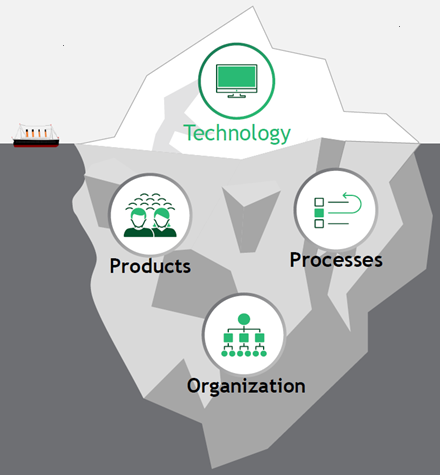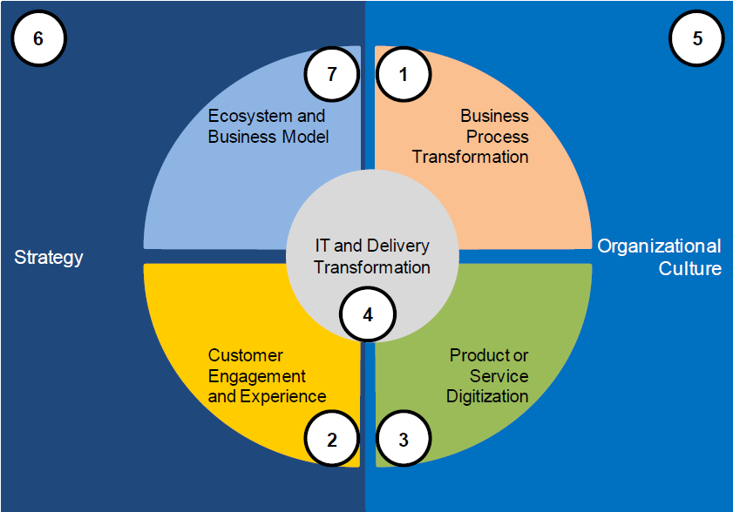The noun and the adjective in Digital Transformation
By Francisco Ruiz (University Professor)
In recent years the term Digital Transformation, TD from now on, has been widely used and commented on. Economists, businessmen, politicians, engineers and pundits have spoken and continue to speak about its importance, interest and characteristics. But not everyone thinks the same thing when they say TD and not everyone does it with the same interests and goals. We are going to try to clarify the concept a bit, explaining what TD is and what it is not, so that we can then understand why it is so important and the fundamental role that computer scientists play in it.
In Wikipedia we find that DT “is the change associated with the application of digital technologies in all aspects of human society”. This definition is general enough to understand different things depending on the point of view or professional profile of each one. In my opinion, the first thing that should be clear is that in the term TD, transformation is a noun and digital is an adjective. That is, in TD the substantive is to change, modify, transform; and digital is the fulcrum of that change. In other words, we should not confuse TD with digitization or the use of digital technologies for information management. Make a web page, implement a CRM or use big date or 5G is not TD. Computer scientists have been helping to digitize society and organizations for several decades, more and more and better, thanks to the spectacular advances in information technology (IT). But only recently has it been proposed that companies and organizations change the way they function from top to bottom to take advantage of IT and become an organization where digital is an essential part of its existence, its internal functioning and its relationship with the outside.
'The open group' (TOG), one of the world's leading players in IT, tells us that TD is “fundamentally, a strategy and a change in the way of operating, in which advances in IT are used to improve human experiences and efficiency internally, and to evolve products and services for customers and users”. From this definition it follows that a company needs to do four important things to carry out a true DT: change its mentality (cultural change), train staff in digital skills and abilities, change its organizational and management structure to adapt to the new world digital (with digital products, services, customers and partners), and gradually incorporate the appropriate IT. The catalog of these technologies is growing. Some have served to improve the way in which companies carry out their daily tasks such as buying, selling, invoicing, accounting or controlling the warehouse. Others, more disruptive, have brought about authentic revolutions in some economic sectors. Remember the video stores?
In recent years, digital technologies that have become 'enablers' for DT include, among others, internet of things, 3d printing, mixed reality (virtual+augmented), date (in its variants, big, science, analytics, etc), blockchains (blockchain), robotic process automation (RPA), and artificial intelligence (AI). To these are added other technologies to provide operational support and infrastructure, such as cloud computing (cloud), cybersecurity, virtualization or 5G. All of them can play a key role in the DT of an organization, but their simple use is not DT, but digitization.
In order to carry out DT taking advantage of these technologies, companies increasingly need more qualified IT professionals. These professionals must have the technical skills and knowledge to manage the corresponding IT. They also need to be able to look beyond pure technology, avoiding a source of many failures in TD, known as the 'Titanic' effect (figure 1): looking only at the visible part of the problem, the technological part, without thinking about the much hidden (products, processes, people and organizations). TD is going further than implementing digital technology. Using 5G and continuing to do things the same as before is not TD, and it also means wasting the opportunities that technology offers.
Figure 1. DT is like an iceberg to IT experts, with most of it hidden.

What does it mean in practice to carry out the TD of a company, an administration or any organization? According to TOG, in its report “The Seven Levers of Digital Transformation – Guidance for Decision-Makers” (the seven levers of DT – guides for decision makers), involves intervening in the following seven aspects (figure 2): transformation of business processes, experience and commitment to the client, digitization of products and services, delivery transformation through IT, organizational culture, strategy, and ecosystem and business model.
Each of the aforementioned seven levers is a different aspect of the TD. To be successful, it is necessary to adjust each lever so that they all allow us to navigate in the same direction. The short history of DT is checkered, with great successes and also great failures without any clear realization of value. The most common cause of these failures is the inability to perform a complete TD due to not being able to intervene in all the levers.
Figure 2. The seven levers for a successful TD (TOG).

Computer professionals can play a relevant role in the seven levers. The transformation of business processes seeks more efficient, productive and agile ways of doing things. For this, computer experts qualified in software technologies such as RPA (robotic process automation) and BPM (business process management), which can add value quickly and clearly. Customer experience and engagement refers to how new [digital] products or services are perceived by customers or users and whether they meet their expectations. Experts in traditional software technologies such as CRM (Customer relationship management) and in software for advanced data analysis and data mining, which help to personalize and learn much better and with more precision the interests of each type of user. The third lever, digitalization of products and services, is the one that best fits with the traditional roles of IT professionals, since it is about creating products or services that take advantage of the practically endless opportunities of IT to focus on the wishes of the client. . IT delivery transformation focuses on new, more agile, diverse and flexible ways to reach customers. For this, qualified computer scientists are needed in, among other technologies, web services, block chains or the internet of things, in the case of physical products.
A priori, it seems that the three remaining levers, organizational culture, strategy, and ecosystem and business model, have little or nothing to do with IT. But this is not the case because when carrying out the DT, the digital and its technology become part of the DNA of the new organization. For example, there is no longer a corporate strategy and an IT strategy, which must be aligned with the first, but only a general strategy is considered, encompassing within it, as an essential aspect, the digital. Thus, new IT profiles can play a key role, for example, in data-driven decision-making, optimizing portfolios of projects, products and services, creating corporate intelligence (making better use of the knowledge of all staff, especially with AI), identify new business models (ways to earn money) based on digital, or plan and manage changes. Clear evidence of this is the very high-level responsibilities assumed by IT specialists in positions such as CIO (Chief information officer), CDOs (chief-data officer or chief-digital officer) and CTO (Chief Technology Officer). Someone needs to be able to explain to company managers how, for example, 'blockchain' can help them offer new products or services or improve existing ones. That someone needs knowledge and qualification in IT to, after 'convincing the bosses', be able to guide and direct change projects based on that IT, or any other that interests, to a successful conclusion.
In sum, we can conclude that DT is a large and complex change effort that necessarily requires the participation of multiple profiles and IT roles. That is why IT professionals are very necessary, although it is important for all of them to be aware that TD is not simply digitizing, and to remember that the danger is in the submerged part, the largest, as in a iceberg.











